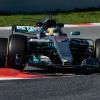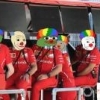As in Silverstone, Mercedes suddenly dominated the straights again. On Friday with up to half a second and five km / h at top speed.
In England the difference on the power sections was even bigger. Red Bull then reacted at the Hungaroring with a smaller rear wing from Saturday, but that only resulted in a tie. That only allowed one conclusion: Mercedes overtook Honda again in Power-Play.
But how are such jumps possible with a frozen engine development? How can you fall from one extreme to the other from one race to the next? Red Bull maintains stiffly: "We are driving the same power as in France and Austria. Mercedes has gained performance." That is denied by the opponent. "We have the feeling that Honda has taken a step backwards. Everything is exhausted with our engine."
These are the official statements. Between the lines, the two title rivals and their allies sprinkle stories that are supposed to explain the puzzling turnaround in the power duel. There is probably a bit of truth in both versions that are circulating through the paddock. But it is difficult to determine from the outside how much poetry, wishful thinking or politics is involved.
From the Mercedes corner you can hear that Honda has been slowed down by a directive of the FIA. Allegedly, there has been a disagreement about how the Japanese operate their energy management for four months.
When asked, the FIA did not know anything about a measure against Honda. Which doesn't have to mean a lot. Corrections to the engine are usually not made public. The technicians of the association discuss this directly with the relevant manufacturer. Not even the competition finds out about it.
Another explanation comes from the orbit of Red Bull. Ferrari should also be on the trail of this theory. Allegedly, Mercedes cools the air collector (plenum) in certain phases in order to have more power available. Before a qualifying round or the start of the race, this would be allowed, but only with archaic methods. So you can cool down the plenary session with dry ice. But the effect evaporates relatively quickly.
Systematic cooling of the plenary would at least be a gray area or not allowed at all. "Especially if you support the cooler air in the collector for a short time by injecting more gasoline," it says from the Red Bull warehouse.
People became suspicious when Lewis Hamilton caught up with Verstappen every time before the Copse corner at Silverstone with a considerable excess of power, which ultimately led to the accident. Mercedes explained this with the fact that the Honda drive had always switched to charging mode at this point. The defending champion denies the accusation of increased performance via any cooling measures.
![]()





































